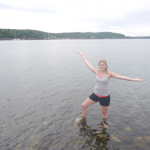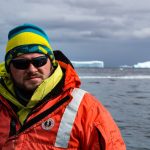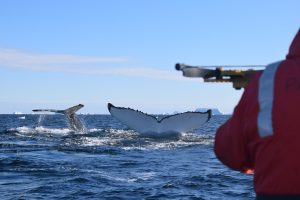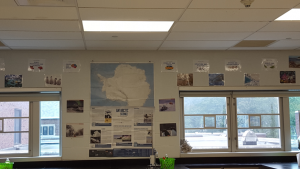Bringing Whale DNA to High School Students – story of the teacher-scientist partnership
We interviewed Alexis Custer, a Palmer LTER RET, and Logan Pallin to hear a bit more about their teacher-scientist partnership as they developed a data-focused lesson plan for high school biology during the summer of 2016.
The Data Nugget: When Whale I Sea You Again?
Explore molecular techniques to answer ecological questions while diving into the marine ecosystems around the Western Antarctic Peninsula (WAP) through the Palmer Longer Term Ecological Research project. Using abundance and sex ratio data, students explore the Humpback whale population in the austral summer time around the WAP. This Data Nugget was designed to be part of a molecular unit. Often when DNA and molecular genetics is taught the focus is on “mistakes” or crime scene investigations. This Data Nugget allows the teacher to illustrate the use of PCR and Gel Electrophoresis to understand the recovery a species.
Teacher Partner: Alexis Custer
- What school do you teach at, how big is it, and is it an urban/suburban/rural school? – Alexis teachers at Princeton High School, which has around 1600 students in the suburban town of Princeton, NJ.
- How many years have you been teaching? – Alexis is currently in her 10th year of teaching.
- What course(s) and grade level(s) do you teach? – Currently, she teaches 9th grade Biology and 11-12th grade Forensic Science.
Scientist Partner: Logan Pallin
- Where do you work? – Logan is currently a graduate student (masters) working in Dr. Ari Friedlaender’s lab at Oregon State University. He is in the Fisheries and Wildlife program, but also part of the Marine Mammal Institute.
- How long have you been working on this project? – Logan started working on this project as an undergraduate at Duke University back in 2012 when he met Dr. Friedlaender and became interested in his work on Antarctic humpback whales.
- What is your research interest? – Logan is currently interested in the conservation of cetaceans in and around the Antarctic continent. He is specifically interested understanding how a populations current demography has changed over time. Some of the tools he uses to describe a populations demography are genetics and endocrinolgoical approaches.
About the partnership to develop the Data Nugget:
- What data were you originally excited to include in your classroom? – Alexis says that during the Polar-Ice Sci-I Project workshop, it was fascinating to hear about Logan’s research and his journey to his Master’s Thesis topic. The data on humpback whales was new to Alexis, so she was drawn to something she did not know much about. She originally wanted to use the data to enhance my ecology unit, but as she learned more about Logan’s research, she felt as though it was more fitting in her molecular genetics unit, and thus the Data Nugget began to evolve.
- What did you want your students to take away? – So often the topic of DNA and molecular genetics is taught through the lens of what could possibly go wrong, never the conservation research that is being conducted. Alexis wanted to create an activity that illustrated the use of molecular genetics for positive ecological purposes.
- What data were you able to provide to the teacher to help support the development of their idea to bring the data into the classroom? – Logan was able to provide the genetic sex data that they obtained from all of his biopsied humpbacks along the Western Antarctic Peninsula.
- How did you deconstruct the science for the students? –
- Alexis commented that she read Logan’s proposal to understand ‘the how and why’ of his project. Upon understanding that the DNA extraction process he uses for the whale blubber is not much different than extracting DNA from strawberries, she knew she was going to create a molecular genetics – ecology hybrid activity.
- Logan says, well first and foremost we completely separated all of the “sciencey” and genetic jargon that is associated with his work and developed simple visuals of the data to make it more applicable and relatable.
- How did the Data Nugget evolve over conversations with the scientist? – Logan originally passed along his research proposal which was data heavy and it made Alexis unsure of where to start. We had conversations based upon determining their sex, determining pregnancy and lastly mtDNA to determine the locations of the breeding grounds that the whales travel from. Originally, she wanted students to analyze gels to determine the sex of the whales and then calculate the ratios of male to female. Once she visualized Logan’s gels, she realized that this could possibly prove to be a tedious task for students, and they may not gain any skills, or make a strong connection to the data, from this task. Logan provided a great resource in the the excel data sheets (2014-2016), and started to manipulate the data to determine what graphical images she could provide students with that would allow them to answer questions standardized to the Data Nugget format. She hoped to include data about the breeding ground standards and mtDNA, but upon closer consideration she determined that the scope of including the appropriate background information and data series would be hard to incorporate with the sex ratio data and maintain its digestibility for the students.
- How did the Data Nugget evolve throughout the development and what role did classroom constraints play in this evolution? – Alexis changed the focus to molecular genetics so that she could give it the time it deserved, because our ecology unit is already busting with activities. She plans on doing the Data Nugget as an extension activity to tie in ecology and data analysis after her class completes an activity where they extract DNA from strawberries during the spring semester. She feels as though this lab, while fun, can be slightly anti-climactic because they pour the DNA down the drain. She plans on watching the videos of Logan’s extraction process, replicating that same process with strawberries, and then concluding the lesson with the Data Nugget.
- What helped you be successful in this partnership? –
- Alexis says, having patience to look through the enormous amount of data and pinpoint specific questions for Logan so she could then deconstruct the content for my students helped her be successful in the partnership.
- Logan says, the ability to approach this workshop with an open mind and to be always willing to approach things from a different angle to make them more meaningful helped him be successful in the partnership.
- What were challenges you faced in this partnership? –
- Alexis commented, being on opposite sides of the country with conflicting obligations to find a time to chat was a challenge.
- Logan says, what he struggled with the most was keeping on task, in terms of ideas and data, with what we think this age group could comprehend. He would love to see all his data accessible in this fashion in order to stimulate k-12 students and help them develop their identity as scientist. Also, as a scientist, not using the scientific “jargon” that he uses when talking/discussion data with colleagues is sometimes challenging. However, he thought everything went great.
- What have you learned about the audience from this partnership? – Logan says what surprised him the most is how interested not only the students, but the teachers are in their work. This has been very humbling to him to see that teachers want to help promote his conservation efforts in the classroom.
Final Thoughts:
- Has participation in this partnership influenced your ability to more effectively communicate? –
- Alexis responded that it made her more comfortable with reaching out to experts in specific fields to create activities for her students based on science that is currently taking place. She will definitely not hesitate to reach out to other science professionals in the future to ask if they would want to collaborate with her students.
- Logan commented, absolutely! Again as mentioned above, this workshop/exercise/product has allowed him to practice communicating efficiently with k-12 students and community members. This is important to him because he truly want to play as a positive role as schools often times lack the excitement of science that got him hooked. Again, he wants to help foster these student’s identity as a scientist.
- What are some overall lessons that you’ve learned from this partnership? –
- Alexis says, don’t hesitate to ask for help if you are unsure.
- Do you have a story related to this partnership that really touched you? –
- Alexis commented, Logan is a fantastic guy that is so giving of his time and energetic about his research. It truly was a wonderful experience to get to work with him.
- Logan commented, the overall enthusiasm and interest that Alexis showed in his work was truly telling.





